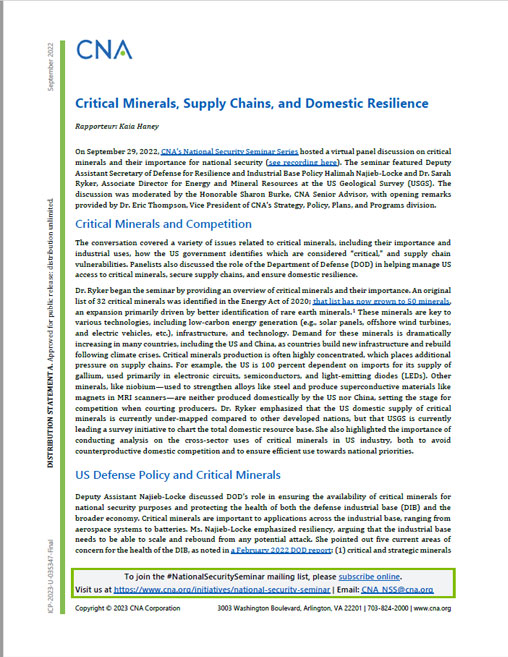On September 29, 2022, CNA’s National Security Seminar Series hosted a virtual panel discussion on critical minerals and their importance for national security (see recording here). The seminar featured Deputy Assistant Secretary of Defense for Resilience and Industrial Base Policy Halimah Najieb-Locke and Dr. Sarah Ryker, Associate Director for Energy and Mineral Resources at the US Geological Survey (USGS). The discussion was moderated by the Honorable Sharon Burke, CNA Senior Advisor, with opening remarks provided by Dr. Eric Thompson, Vice President of CNA’s Strategy, Policy, Plans, and Programs division.
Critical Minerals and Competition
The conversation covered a variety of issues related to critical minerals, including their importance and industrial uses, how the US government identifies which are considered “critical,” and supply chain vulnerabilities. Panelists also discussed the role of the Department of Defense (DOD) in helping manage US access to critical minerals, secure supply chains, and ensure domestic resilience.
Dr. Ryker began the seminar by providing an overview of critical minerals and their importance. An original list of 32 critical minerals was identified in the Energy Act of 2020; that list has now grown to 50 minerals, an expansion primarily driven by better identification of rare earth minerals. These minerals are key to various technologies, including low-carbon energy generation (e.g., solar panels, offshore wind turbines, and electric vehicles, etc.), infrastructure, and technology. Demand for these minerals is dramatically increasing in many countries, including the US and China, as countries build new infrastructure and rebuild following climate crises. Critical minerals production is often highly concentrated, which places additional pressure on supply chains. For example, the US is 100 percent dependent on imports for its supply of gallium, used primarily in electronic circuits, semiconductors, and light-emitting diodes (LEDs). Other minerals, like niobium—used to strengthen alloys like steel and produce superconductive materials like magnets in MRI scanners—are neither produced domestically by the US nor China, setting the stage for competition when courting producers. Dr. Ryker emphasized that the US domestic supply of critical minerals is currently under-mapped compared to other developed nations, but that USGS is currently leading a survey initiative to chart the total domestic resource base. She also highlighted the importance of conducting analysis on the cross-sector uses of critical minerals in US industry, both to avoid counterproductive domestic competition and to ensure efficient use towards national priorities.
US Defense Policy and Critical Minerals
Deputy Assistant Najieb-Locke discussed DOD’s role in ensuring the availability of critical minerals for national security purposes and protecting the health of both the defense industrial base (DIB) and the broader economy. Critical minerals are important to applications across the industrial base, ranging from aerospace systems to batteries. Ms. Najieb-Locke emphasized resiliency, arguing that the industrial base needs to be able to scale and rebound from any potential attack. She pointed out five current areas of concern for the health of the DIB, as noted in a February 2022 DOD report: (1) critical and strategic minerals and materials, (2) batteries and energy storage, (3) micro-electronics, (4) casting and forging, and (5) kinetic capabilities.
DOD has multiple tools at its disposal to protect the health of the national supply of critical minerals. One is the National Defense Stockpile, which is a physical stockpile of critical minerals and other goods that can serve as a safety net in case of supply shocks. Another tool is the Defense Production Act, through which DOD can work with private sector partners to prioritize the production of needed goods and manage large-scale investments to help prevent shortfalls in the future. Via the Defense Production Act, DOD is leading the charge on developing a national supply of critical minerals by investing in domestic mining and processing capabilities. Finally, DOD is also working with US partners and allies to help open up supply chain bottlenecks, including via “near-” and “peer-shoring” (moving supply chains closer to the US, specifically to allies and friendly countries) and supply agreements with other countries.3 Ms. Najieb-Locke noted that while reducing dependency rates will be costly and results may not be immediately evident, it is critical to US national security. For the US to be successful, she argued, it will have to take an ecosystem approach, not only collaborating with the private sector, but working closely across the interagency and with Congress as well as partnering with US allies abroad.
Download reportDISTRIBUTION STATEMENT A. Approved for public ICP-2023-U-035347-Final release: distribution unlimited.
Details
- Pages: 2
- Document Number: ICP-2023-U-035347-Final
- Publication Date: 9/30/2022
